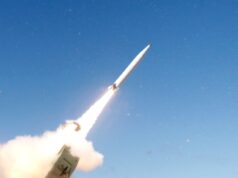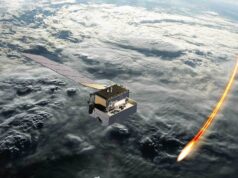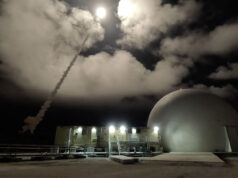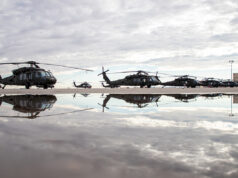The V-22 Osprey surpassed the 600,000 flight hour milestone in February, a count beginning with first flight in 1989.
The milestone is attributed to the U.S. Air Force Special Operations Forces, Marine Corps and Navy squadrons flying and maintaining an inventory of more than 400 aircraft in fleet operations, training and flight test around the world, say NAVAIR here.
“Each V-22 flight hour is the product of a team effort,” said Col. Matthew Kelly, V-22 Joint Program Office program manager.
“Enabled by pilots, maintainers, testers, engineers, the program workforce and our industry partners who, together, ensure safe and effective V-22 operation.”
According to the NAVAIR release:
“The Marine Corps’ Common Configuration – Readiness and Modernization (CC-RAM) program continues to make progress, delivering three aircraft to date. The CC-RAM program reduces the number of configurations in the MV-22 fleet to a handful, streamlining maintenance times, improving readiness and enhancing capabilities and reliability.
For the Air Force, Naval Air Systems Command recently awarded Bell Boeing an $81 million contract to develop, design and install nacelle modification kits and install conversion area harnesses on the CV-22. The program refines the design of the nacelles and wiring harnesses for better maintainability, ultimately reducing repair time and improving readiness.
Finally, the Navy continues flight test of the CMV-22B, the newest V-22 variant designed to take on the Carrier Onboard Delivery (COD) mission, replacing the venerable C-2A Greyhound. The CMV-22B will be capable of transporting up to 6,000 pounds of cargo/personnel to a 1,150 nautical mile range. The V-22’s ability to take off and land vertically, as well as short-takeoff-and-land, makes it more versatile than the stalwart C-2A, further allowing the Osprey the flexibility to serve any shore or sea base as well as aircraft carriers and amphibious ships.”
The V-22 family of aircraft are designed to fly for the next 30 years and remain the only tiltrotor in production.









Cue obvious comments and counter comment about the V-22
I’ll give you both in one comment, would be an absolute game changer for the carriers but would come at the cost of the T31 fleet
Will the V-22 fit the lift on the QE?
Yes
Any ideas about the cost, say for 10?
£700 million for purchase, then add in training both air and ground crews, add the costs of adding a new type and you basically come up with the costs for the T31 program
Also, as we have been over a few times on here, there is a defect in that the engine intakes regurgitate the prop wash. So any garbage FOD on the deck can get ingested.
Too expensive
1st gen design
Things are moving fast with UAV’s which are well suited to the COD role and maybe the AEW role too – if you can generate enough power and cooling….
Must be a bugger with all them McDonalds wrappers floating around on the USN Ships !
Shame there is no like option in the comments here
Well Thanks anyway…. It would have been a first for me !!!!
I’ll second that!
Consider your comment liked.
Nice thought, but fast-food chains are not present on US Navy ships.
I would also pose the question that in a time of war would a Poseidon or a Wedgetail not be attached to the CSG and also is the F35 itself not capable of fulfilling an AEW role?
The F35B is sort of capable but as far as I know the radar only covers 135 degrees at high resolution.
E7 or more usefully the P8 are great apart from the issue of range, refuelling & persistence.
So if the CSG was in UK or friendly waters then yes over watch is possible. However, that slightly negated the purpose of CSG: go anywhere.
AEW needs to be persistent for both deference and effect.
If there was one thing RN (re)learned in ‘82 was that a CSG must be self reliant.
Are either the Poseidon or Wedgetail able to be AARd?
I think I suggested some time ago that two (or poss 3) F35Bs flying a race track above the CSG could provide a continuous 360deg coverage over a wide radius than the T45 radar. Comments, anyone?
That is probably correct and does at least partially make sense in a CAP role.
The problem is that once the hounds are chasing a hare your radar picture is whatever they are chasing and only facing the hare.
I’m perfectly sure the real answer is that the picture will be a fusion of T45 radar, F35 radar and CrowsNest plus maybe the Thales radar on the carriers which is quite high up but that will probably be used passively picking up reflections from other sources.
I was reading the US Navy have been experimenting with ‘Blackwing’. Unfortunately impractical for AEW if tube launched. But I wish our future subs all had flexibility of a Common missile compartment.
In near future my best hopes are for a cheaper V-280 type aircraft or something like the proposed USMC’s MUX UAV.
I still wish we went for Cats & traps and bought the F35C.
Not that I know the type but, when I was letching over one of these a few years ago, I assumed the hole under the intake was a pneumatic spike to reduce FOD? or is that an anti-ice outlet? you seem to be the go-to guy SB!
You might be interested this on the V22 usage: just tripped over it looking for something else.
http://www.bits.de/NRANEU/others/jp-doctrine/jp3_04%2812%29.pdf
I’ve just skimmed through it and it is possibly in competition for the dullest document on earth: a restatement of everything you would expect minus the interesting bits!
Yes. That’s the cost of a fighter bomber. Is it realistic to lease 4 or 5?
Like we did with the C-17?
The only reason that was done was one G Brown Esq didn’t like putting anything on the capital books and preferred to lease or PFI everything.In the end the RAF bought them as it was cheaper and they could then modify them.
Don’t get me started on air tanker……
For a multi role truck, like the V22, not being modify it would be a disaster.
Judging by
a) the catapult RFI; and
b) where real UAV’s are ending up performance wise; and
c) UAV being on the UK defence ‘modernisation’ agenda.
It seems likely that CrowsNest will be replaced with a UAV on Merlin OSD or maybe before – would free up cabs for other jobs. Quite what this will look like is an open question. Previously the runes appeared to be some kind of tilt rotor or helo type effort. Now with the catapult option there might well be a winged version – as it does not need high speeds (apart from evasion) and just needs to be able to keep up with the CSG: winged persistence is probably easier to do. The only thing that militates against winged/catapult is the sea states that it can be launched and recovered in.
Anyway there are options and I would be reasonably sure that USM V22 will be around for the CSG deployment this year. I don’t think they would have bothered to QEC qualify it if they were not going to do something with it. But maybe not!
Honestly I don’t see anyone pursing the V22 radar option. It would be a very very expensive way of getting a radar in the air. A role that both USN and USMC see as being UAV based from everything apart from Nimitz and Ford classes.
All fair points. I was only thinking about a temporary lease.
Costs aside, these tilt rotors might be suitable to carry a suitable load. (?)
Haha, thank you. Note the comments still follow.
Well, we all know QE/PoW need them, but also know HMG is unlikely to buy them.
QE/PoW do not need them. The UK Government need to get British companies working on kit to do an equivalent or better job at a fraction of the price.
Problem is it won’t be at a fraction of the price. We waste billions on developing ‘ home grown products’, then realise they won’t work (AEW Nimrod/MR4A prime examples) and end up with very little left with which to buy limited numbers of already proven off the shelf products we should have gone for in the beginning! The Osprey is proven, the US has paid for all the development costs, just buy it!!
I think you have hit the nail on the head. The UK must be able to produce kit in sufficient quantity and at a decent price. It is not good enough to say “Oh we are too stupid or inefficient” we have to remove the waste and inefficiency and build good simple products in quantity and in the UK. The drone programme seems a good place to start.
I’ve no problem with the principle of buying from any other Country providing they are buying from us!
If the MOD is incapable of reforming then perhaps this needs to be taken out of the control of the MOD. Procurement for big projects is not easy but it is possible and must happen.
Osprey AEW exists purely as a CGI image.
Good luck getting that Nimrod-esque science project to work.
Obvious candidate for carrier AWAC role but too expensive at $100 million plus per copy. Cheaper alternative would be AW609 or better still a remote controlled (UAV) version of the AW609 with AESA radar system and secure data link.
No doubt V 22 would of been great in this role longer range and more hight then Merlin but UK wont pay out.?
And for very good reason. They cost a fortune.
Are we in danger of forgetting why/what?
E2D looks at a resolution well suited to finding ship, aircraft and other goodies – “mapping the scene”. I have zero knowledge of how good its clutter suppression is.
CrowsNest looks mostly down and at a resolution (higher frequency) that excels at discerning sea skimmers and periscopes etc.
Maybe the theory is that the cone looking down, from CrowsNest, overlaps with the cone looking up, from the Sampson sets? Maybe?
The one thing I am certain of is that CrowsNest will be better at detecting skimmers than E2D.
I really wouldn’t underestimate the quality of what we now have: on ship.
Actually low flying skimmers is one of the things the AN/APY-9 on the E-2D has been optimized for. It’s now widely reported that the radar can detect fighter size low rcs aircraft and is able to do this over water and even in littorals. It is the main asset in the entire CEC concept developed by the USN and a generational leap for naval radars.
It’s not quite as simple as that unfortunately. Not only does the radar’s performance rely on the target’s RCS, but also the operating frequency. These do go hand in hand, but its not as simple as that. The E2D can detect a Hawk sized jet over 400km away. It can also detect a P700 Granit sea skimming missile at least 200km away. They won’t publish the exact figures. The Granit’s RCS is much smaller than the Hawks, but its not a missile designed with stealth, but due to its physical dimensions being slightly smaller and its overall shape (no cockpit cavity helps massively). It has a length of 10m, with a body diameter of 0.85m and a wingspan around 3m. It can fly as low as 15m at speeds over Mach 2.
The Crowsnest’s X band Searchwater radar will easily detect this missile and with very good angular resolution, at a far cheaper price (ok, at a lot less range).
Lockheed Martin have been quite canny how they have described the AN/APY-9 radar as a UHF radar. This gives it a possible frequency range of 300MHz to 3GHz, with a corresponding wavelength of 3m down to 30cm. This means it also covers the traditional L band, but also half of the S band. These two bands are traditionally used for volume search radars and some targeting radars, e.g. S1850M = L band, Sampson = S band.
On the face of it, the radar could be operating with a wavelength anywhere between 300cm to 30cm, which at a 1/4 wavelength would be 75cm to 7.5cm. This means the antenna feed horns used within the transmitter-receiver module (TRM), that form the AESA’s antenna array, must measure at the most, between 75 and 7.5cm in height. Clearly the radar won’t use the 75 cm horns, as this means they could probably only pack two or three rows within the rotating radome. This is important, as the more rows and columns you use, will decrease the vertical and horizontal beamwidth, i.e. more TRMs = better, but also increases the target’s resolution.
These differences in wavelength are incredibly important on how the radar interrelates with the target, but also how the radar sees the target resolution wise. At lower than 1 GHz frequencies, Rayleigh scattering plays a big part in allowing these radars to detect “stealthier” objects. As straight edges and tubular bodies with a length or diameter less than 1/2 the radar’s wavelength will cause a form of resonance, that generates backscattering. Therefore, the size and dimensions of a target will determine its radar cross section and how that particular radar detects it.
The other issue these longer wavelength radars face is angular resolution. As an AESA radar transmits its narrow beam, it will diverge over distance, i.e. gets wider the further it goes. Therefore, at distance the radar’s beam has a significantly wider diameter than a smaller X band AESA radar, due to the operating wavelength. But also the energy contained within the beam, is spread out further. This means the target could be anywhere within the diameter of the beams at the detected distance. As the target is reflecting less of the beam these both combine to give a poor targeting resolution. But also you become more reliant on backscattering to detect the target. Traditionally radars operating at these wavelengths were very poor at not only detecting smallish sea skimming missiles but also tracking them, especially if they changed directions frequently. Lockheed Martin have got round this problem by throwing heaps of expensive signal processing at it. This is the main reason why the radar/E2D combination costs so much.
You could do just as well with detection range, with as good if not better target resolution (less complex signal processing), by using a higher frequency radar. However, you would have to significantly increase the gain of the transmitted signal to compensate for atmospheric attenuation. This would necessitate significant amounts of electrical generation. But perhaps more importantly, using lots of active cooling, especially for the power amps, required to ramp up the transmitted signal’s power. Jus look at the USN’s Sea Based X-Band Radar (SBX-1) as an example of what is feasible. The SBX-1 platform also shows what is required to operate an X band radar for lang range searching.
In the end it’s a balancing act over required detection range vs signal processing costs. The USN have the available funding to not only develop “UHF” radars, but also paying for the research and development on the required signal processing, that can be fitted inside a relatively small airframe, that has the same computing power used for an Arleigh Burke’s SPY radar (not SPY-6). We do not!
Daveyb
Thanks for your detailed response. Always look forward to your post for that exact reason TBH. With regards to crowsnest, while it’s not the AN/APY-9 level of sophistication, I think it’s more than adequate for the way the RN intends to use it. What often gets lost on these sites and i’m guilty of it myself is we tend to focus on specs and forget about the tactics developed to use the systems. I’m certain the RN have tested and have developed methods the tactics that allow them to be confident in how crowsnest will be employed.
Yes, I agree. Crowsnest’s primary focus is against sea skimming missiles, rather than high altitude or ballistic threats. These high altitude threats are better left to the ship’s radar’s line the S1850M. The placement of the radar on the Merlin kind of gives it away. Compared to the E2D’s radar placement which has a dead zone below the aircraft.
After 50 years of continual development the Searchwater is about as far as it can go development wise. The updated software and newer backend have made sure its still relevant against small stealthy targets. Being designed to search for periscopes and snorkels helps in this regard. Hopefully the MoD have a plan in place for its replacement and possibly the type of aircraft that will carry it.
Bootlicker strikes again
That comment makes no sense, what or who is the Boot Licker ?
🙂
Don’t worry mate, it’s aimed at me. ?
Here have a coffee ☕ from the RN
LOL Sole. Behave mate.
That has reminded me of the Pink Panther films and Star Wars trilogy.
“Bootlicker Strikes Again”
“The Bootlicker Strikes Back”
“Revenge of the Bootlicker”
“Return of the Bootlicker”
PMSL….
Well, I’m confused about this to be honest, I guess this Sole bloke is either a troll or a part time poster here. Any one know what He’s on about ? I think I had a bit of a telling off here by him a while back……… not that I give one. lol.
He Sounds like a Twat if you ask me
No mate, he’s been here since the beginning, so he’s a type of Forum God truth be known, or so he keeps telling us on here.
Sole? I don’t think so.
But I’ve been around here long enough to remember when he was a regular poster.
Got a lot if time for the guy to be honest, he’s always treated me with respect.
Read the other threads mate, just an ongoing spat. Hillarious.
Ah, Mr Survivor, we meet again. Got any Mach 5 8th gen fighters you want to ask me about ?
Its a proven product, highly rated and would give us a far greater capability. A huge problem we have right now is lack of an LPH. We can’t use a QE because the limited range of our helicopters means she would need to be in shallower hostile waters to launch. Osprey can launch from a far greater distance, hence its use with USMC. Its worth the money.
I completely agree capability wise. But we just don’t have the funds for it unfortunately. Anyway, we can invite the USMC along if need it ?
$100 million is a lot, but compared to the cost of a QE carrier and everything (and everyone) on board? “Penny wise, pound foolish.” AEW is not a capability gap that is tolerable.
Then add the cost of pilot and engineering training, maintenance contracts, new facilities and infrastructure at whatever station they would fly from, simulators, engine maintenance contracts, spares & logistics, upgrades and continous software drops. All that adds up to a lot of money for a small fleet of aircraft. Crownsnest combined with the ISTAR capability of the F35, along with the air & surface picture from the T45 & T23’s and the carrier’s own radar will provide superb all round coverage. Plus a AEW V22 doesn’t exist. Large UAV’S will probably take over AEW after Crownsnest
Two Merlins for a V22
Just like to see the best for our guys, don’t you far from a Boot Licker ??
Never said you was Andrew! Think you replied to the wrong person.
That I did David seen my mistake sorry about that mate won’t say who it was for not much point now .Keep posts coming ?
Why? A few CGI images of a radar painted on top and people think this would be an E2!
Can you imagine a worse design for an airborne radar than one which constantly directs massive choppy air drafts inducing horrible vibration into a very senstive radar antenna and associated avionics?
Or moving rotating large blades smack in about 180deg of coverage?
I’m a fan of the AW609 for an AEW role as it’s a hell of a lot cheaper than V22, though I don’t think it will fit in the QE’s hangars.
I have a feeling that a UAV of some description will end up replacing Crowsnest for our AEW role.
Perhaps a version of Mosquito Loyal Wingman drone, when it is done, could be adapted as an AEW platform for the carriers.
AW609 CANNOT be used for military purpose or sold as such by AW it was in the original design contract with BELL they would be bankrupted in court if they tried
That’s a shame as it would be a good AEW platform.
As I said, though, it’ll most likely be a drone that replaces Crowsnest in time.
I am afraid that was (still is?) another misguided wish by the MoD.
It appears they think helicopters are passé.
Way too expensive for the difference it would make. Given our time scale the V 280 Valor or SB 1 Defiant maybe,assuming we haven’t already come up with a new drone to do the job.
Probably a drone.
Hopefully, with a port waist cat upgrade along with the arrestor system. It will mean the carriers can launch a decent sized UAV alongside whatever comes out of the Lanca program. My personal favorite would be Boeing’s MQ-25 Stingray. This UAV is optimized for aerial refueling. But can also do a limited istar role. It’s a big aircraft, so could take the full length Erieye radar.
The Real Issue behind No V22s for the UK Carriers is there PM Cost and the fact like the Chinook they would come under the RAF, as a transport/cargo. Navy rejected the V22 in the Helicopter Program due COST and being stolen. QE Class designed to take the V22 into hangers. also at the time the V22 Kept falling from the skies and didnt like Sea Water in its Rotor Points. just to expensive for small order of 6.